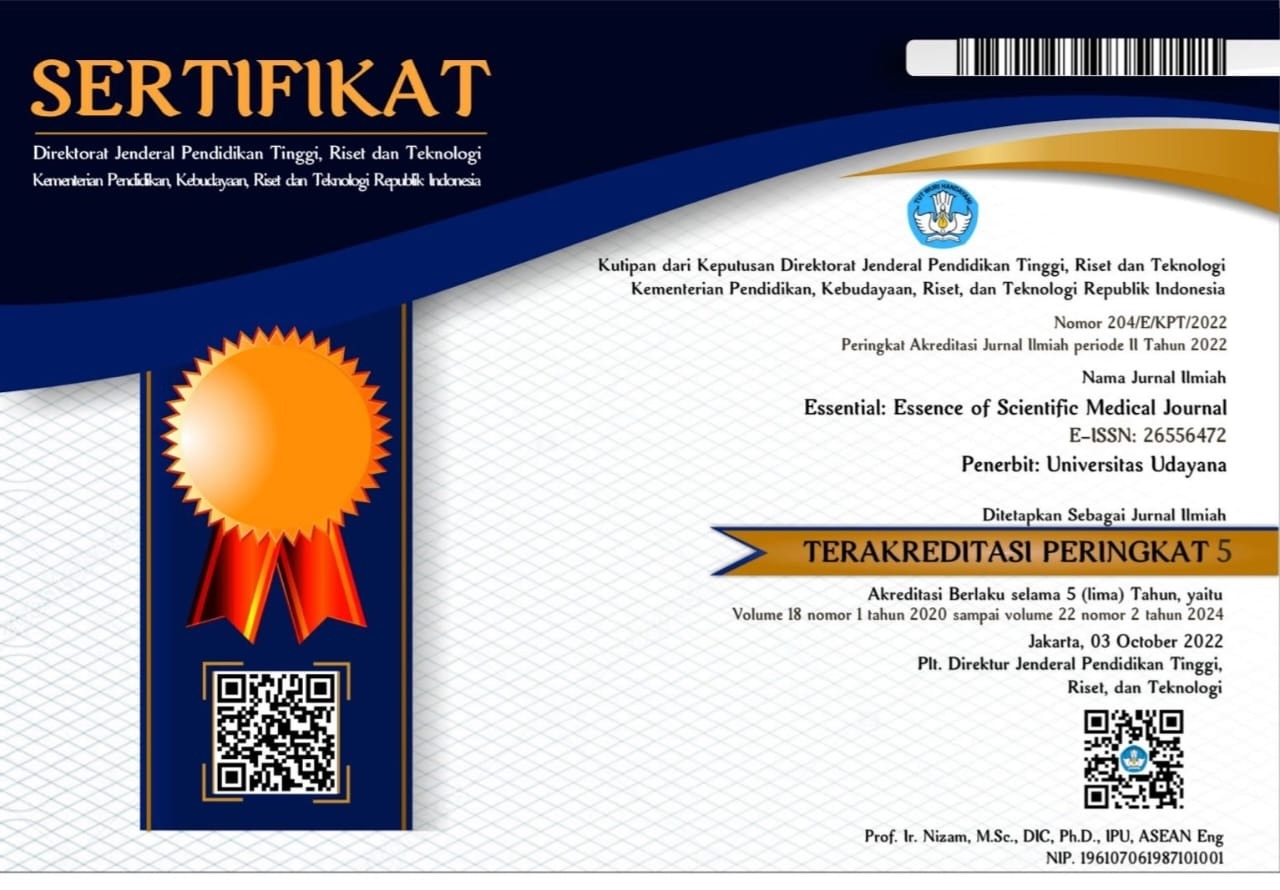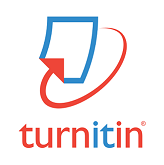THE EFFECT OF SOURSOP LEAF EXTRACT (Annona muricata Linn) ON BCL-2 CONTINOUS CELL T47D ANTI-APOPTOSIS GENE IN BREAST CANCER
Abstract
Introduction: Breast cancer ranks first in the most cases of malignancy in Indonesia. Phytochemical studies of acetogenin as the main substance of soursop have the potential as a cytotoxic agent and trigger apoptosis of breast cancer cells.
Method: This research is a true experimental type using in-vitro studies using continuous cell T47D, the treatment group was given a solution of soursop leaf ethanol extract. The results of this study are seen from the RT-PCR cycle quantification which will be analyzed of the Mann-Whitney Test, and determination of gene expression using the Livak formula.
Result: The results showed that the treated T47D cells expressed 1.36 times higher than the control group cells to express the anti-apoptotic protein BCL-2. It’s a significant difference between the treatment and control groups for the expression of the BCL-2 T47D gene, p=0.002 (p<0.005).
Discussion: Acetogenin is a strong inhibitor of NADH dehydrogenase which can decrease the production of ATP which can cause death in cancer cells. This inhibition can trigger the activation of the apoptotic pathway and the activation of the BCL-2 gene which can stop the cell cycle which will prevent uncontrolled proliferation.
Conclusion: There was a significant difference value of the cycle quantification RT-PCR of the BCL-2 gene in group treatment and control. In addition, soursop leaf extract containing acetogenin was not effective in reducing the expression levels of the anti-apoptotic gene BCL-2 in continuous T47D cells of breast cancer.
Keywords: Acetogenin, BCL-2 gene, Continuous cell T47D, Soursop leaf extract, RT-PCR.
Downloads
References
2. Sergiusz L, Marcin C, Alicja F, Jacek B, Robert S, Andrzej S. Breast Cancer-Epidemiology, Risk Factors, Classification, Prognostic Markers, and Current Treatment Strategies-An Updated Review. Cancers. 2021;13:4287-93.
3. GLOBOCAN (2020c). International Agency for Research on Cancer : Estimated number of new cases from 2020 to 2040, both sexes, age [85+] [Internet]. 2020 [cited 2022 Mar 25]. Available from: https://gco.iarc.fr/tomorrow/en/dataviz/isotype?years=2040&single_unit=5 00000&cancers=20
4. World Health Organization. Global Health Estimates 2016: Disease Burden by Cause, Age, Sex, by Country and by Region, 2000–2016; World Health Organization: Geneva, Switzerland, 2018; Available online: https://www.who.int/healthinfo/global_burden_ disease/esti-mates/en/index1.html (accessed on March, 25th 2022).
5. Ferlay J, Ervik M, Lam F, Colombet M, Mery L, Piñeros M, et.al. Global Cancer Observatory Cancer Today. Lyon: International Agency for Research on Cancer; 2020.
6. Ginsburg O, Bray F, Coleman M, Vanderpuye V, Eniu A, Kotha SR, et.al. The global burden of women’s cancers: A grand challenge in global health. Lancet. 2016;389:847-60.
7. Vostakolaei FA, Karim-Kos HE, Janssen-Heijnen MLG, Visser O, Verbeek ALM, Kiemeney L. The validity of the mortality to incidence ratio as a proxy for site-specific cancer survival. Eur J Public Health. 2010;21:573-77.
8. Ferlay J, Laversanne M, Ervik M, Lam F, Colombet M, Mery L, et.al. Global Cancer Observatory: Cancer Tomorrow. New York: International Agency for Research on Cancer; 2020.
9. Sharma, R. Breast cancer incidence, mortality and mortality-to-incidence ratio (MIR) are associated with human development, 1990–2016: Evidence from Global Burden of Disease Study 2016. Breast Cancer. 2019;26:428-45.
10. Mugi W, Sofia H, Vita A, Rini N. Population based cancer registration in Indonesia. Asian Pasific Journal of Cancer Prevention : APJCP. 2021;13:1709-10.
11. Badan Penelitian dan Pengembangan Kesehatan Kementerian Kesehatan RI. Riset kesehatan dasar (RISKESDAS) tahun 2018. http:// https://www.kemkes.go.id/resources/download/info-terkini/hasil-riskesdas2018.pdf.
12. Gani. Tumor ganas. J Poltekes Jogja. 2017: hal.6-25.
13. Rumah Sakit Umum Pusat (RSUP) Dr.M.Djamil. 2021. Data kunjungan pasien rawat jalan di RSUP Dr M Djamil Padang tahun 2017-2021 di Poliklinik Bedah Padang. Instansi Rekam Medik RSUP Dr M Djamil Padang.
14. Adelina R, Febrianti R, Oktoberia IS, Intan PR. Ekstrak daun annona muricata linn sebagai antiproliferasi terhadap sel hepar tikus terinduksi 7,12 dimetilbenz [a] antracene (DMBA). Kefarmasian Indonesia. 2015;4:1-12.
15. Chitwood K, Etzkorn J, Cohen G. Topical and intralesional treatment of nonmelanoma skin cancer: Efficacy and cost comparisons. Dermatologic Surgery. 2013;39:1306-16.
16. Harahap WA. Pembedahan Pada Tumor Ganas Payudara. Maj Kedokt Andalas. 2015;38:57.
17. Puspitasari ML. Aktivitas antioksidan suplemen herbal daun sirsak (Annona muricata L.) dan kulit manggis (Garcinia mangostana l.). J Pangan dan Agroindustri. 2016;4:283–90.
18. Puspita EW, Pujiasih. Efek ekstrak metanol daun sirsak (annona muricata linn) terhadap pertumbuhan kanker payudara mencit C3H. Buletin Penelitian Kesehatan. 2014;3:17-23.
19. Latief A. Obat tradisional. Jakarta: EGC; 2012
20. Retnani V, Prajoko YW. Pengaruh suplementasi ekstrak daun annona muricata terhadap kejadian displasia epitel kelenjar payudara tikus sprague dawley yang diinduksi 7,12 dimethylbenz (a) anthracene. Artikel Ilmiah Sarjana Kedokteran Universitas Diponegoro. 2011.
21. Muhartono, Subekti. Penggunaan ekstrak daun sirsak sebagai obat kemoterapi kanker payudara. Prosiding Seminar Presentasi Artikel Ilmiah Dies Natalis FK Unila ke 13. 2015;3:1-8.
22. Hussaana A, Djam’an Q, Goenarwo E. Ekstrak daun Sirsak (annona muricata) sebagai penghambat perkembangan tumor payudara. J Farm Sains dan Terap. 2015;2:41-4.
23. O’Brien MA, Kirby R. Apoptosis: A review of pro-apoptotic and anti-apoptotic pathways and dysregulation in disease. J Vet Emerg Crit Care. 2018;18:572-85.
24. Fidianingsih I, Handayani ES. Annona muricata aqueous extract suppresses T47D breast cancer cell proliferation. Universa Med. 2014;33:19-26
25. Dewson G, Kluck RM. Bcl-2 family regulated apoptosis in health and disease. Cell Health and Cytoskeleton. 2010. p. 9–22.
26. Arisanty D. In vitro cytotoxic study and detection of apoptosis on breast cancer cell lines mda-mb 231 after exposed to azadirachta indica a. juss (neem) extract. J Kesehat Andalas. 2013;2:80.
27. Jacobo-Herrera N, Pérez-Plasencia C, Castro-Torres VA, Martínez-Vázquez M, González-Esquinca AR, Zentella-Dehesa. A selective acetogenins and their potential as anticancer agents. Front Pharmacol. 2019;10:1-12.
28. Tsujimoto Y. Role of Bcl-2 family proteins in apoptosis: Apoptosomes or mitochondria?. Genes to Cells. 1998;3:697-707.
29. Yarsi J. Protein kelompok BCI-2sebagai target senyawa antikanker BCI-2- family proteins as target of anticancer drug. 2016;14:238-42.
30. Izabella D, Magdalena K, Rafal S. Evaluation of apoptosis-associated protein (Bcl-2, Bax, cleaved caspase-3 and p53) expression in canine mammary tumors: an immunohistochemical and prognostic study. Elsevier. 2016;16:1-37.
31. Chin Y, Kinghorn AD. Structural characterization, biological effects, and synthetic studies on xanthones from mangosteen (Garcinia mangostana), a popular botanical dietary supplement. Mini Rev. Org. Chem. 2018;5:355-64.
32. Orozco GF, Chitchumroonchokchai C, Lesinski G, Suksamrarn S, Failla M. α-Mangostin: Anti-inflammatory activity and metabolism by human cells. J. Agric. Food Chem. 2013;61:3891-900.
33. Joseph F, Tomashefski JR, Philip TC, Carol FF, Armando EF. Dall and hammars : neoplastic lung disease. New York: Springer; 2016. p.21.
34. Dai H, Meng W, Kaufmann S. BCL2 family, mitochondrial apoptosis, and beyond. Cancer Transl Med. 2016;2:7.
35. Vartiainen S. Caenorhabditis elegans. Encycl Mov Disord. 2010;3:171-73
36. Wong R. Apoptosis in cancer: From pathogenesis to treatment. J Exp Clin Canc Res. 2011;30:1-14.
37. Kumar V, Cotran RS, Robbins SL. Buku ajar patologi robbins/ Vinay Kumar; alih bahasa, Ening krisnuhoni; editor edisi Bahasa Indonesia, I Made Nasar, Santoso Cornain. Jakarta: Penerbit Buku Kedokteran EGC; 2013. p.16-20.
38. Sari LM. Mekanisme molekuler kematian sel. Cakradonya Dent J. 2018;10:65-70.
39. Pistritto G, Trisciuoglio D, Ceci C, Alessia G, D’Orazi G. Apoptosis as anticancer mechanism: Function and dysfunction of its modulators and targeted therapeutic strategies. Aging (Albany NY). 2016;8:603-19.
40. Indrasetiawan P, Astuti I. Activity of -terpineol as a potential anticancer candidate: cytotoxicity, proapoptotic and antiproliferative evaluation in TD47 cell lines. J Med Sci (Berkala Ilmu Kedokteran). 2015;44:10-7.
41. Dencic SM, Poljarevic J, Vilimanovich U. Cyclohexyl analogues of ethylenediamine dipropanoic acid induce caspase-independent mitochondrial apoptosis in human leukemic cells. Chem Res Toxicol. 2012;25:931-9.
42. Nikoletopoulou V, Markaki M, Palikaras K, Tavernarakis N. Crosstalk between apoptosis, necrosis and autophagy. Biochim Biophys Acta-Mol Cell Res. 2013;1833:3448-59.
43. Looi CY, Moharram B, Paydar M, Arya A, Leong KH, Mohamad K. Induction of apoptosis in melanoma A375 cells by a chloroform fraction of centratherum anthelminticum (L.) seeds involves NF-kappaB, p53 and Bcl-2-controlled mitochondrial signaling pathways. BMC Complem Altern M. 2017;13:166-8.
44. Yahaya G. Phytochemical screening, anti-oxidant activity and in vitro anticancer potensial of ethanolic and water leaves extracts of Annona muricata (Graviola). Asian Pac J Trop Med. 2014;7:355-63.
45. Adewole SO, Caxton MEA. Morphological changes and hypoglycemic effects of annona muricata Linn.(annonaceae) leaf aqueous extract on pancreatic β-cells of streptozotocin-treated diabetic rats. Afr J Biomed Res 2016;9:173-87.
46. Chatterjee S, Ovadje P, Griffin C, Tran C, Hamm C, Pandey S. Selective induction of apoptosis through activation of caspase-8 in human leukemia cells (Jurkat) by dandelion root extract. J Ethnopharmacol. 2021;133:86–91.
47. Lienggonegoro LA. Soursop leaf (Annona muricata) and it is potential as an anti-cancer. Pros Sem Nas Masy Biodiv Indon. 2020;6:653-7.
48. Saelens X, Festjens N, Walle LV, Grup MV, Loo GV, Vandenabeele P. Toxic proteins released from mitochondria in cell death. Oncogene. 2012;23:2861-74.
49. Boskovic ZV, Adams DJ, Theriault JR, Wang AJ, Stern AM, Wagner BK, et.al. High-throughput screening identifies small-molecule enhancers of reactive oxygen species that are nontoxic or cause genotype-selective cell death. ACS Chem Biol. 2013;8:923-9.
50. Gellerich FN, Trumbeckaite S, Opaika JR, Seppet E, Rasmussen HN, Neuhoff C, et.al. Function of the mitochondrial outer membrane as a diffusion barrier in health and diseases. Biochem Soc Trans. 2020;28:164-9.
51. Aisha SD, Hetal B, Bryan L, David WA. BH-3 only proteins : orchestrators of apoptosis. BBACMR. 2014;11:508-20.


 SUBMISSION
SUBMISSION
















